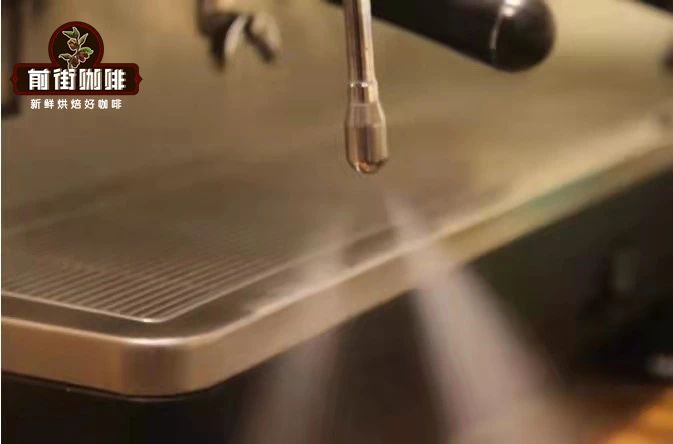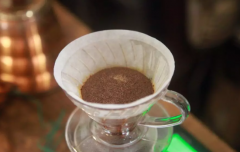Barista skill of the milk foam how to deal with, milk foam what skills and should pay attention to.
The handling of milk foam is a very important step in making a good latte. Novice baristas are easy to beat the milk very thick if they are not careful. How to dispose of a good bottle of milk foam? what affects the stability of milk bubbles is the casein colloidal particles in milk protein and the existence of whey protein casein colloidal particles to form tension on the milk surface. When the steam hits the surface of the milk, a large number of bubbles of different sizes are formed, and then the position of the steam stick is adjusted to make the milk swirl "shredded" larger bubbles, thus obtaining fine bubbles with the same smooth surface. Under normal circumstances, whey protein is hydrophilic in appearance and slowly "unfolds" after stirring or heating, exposing the hydrophobic part. These parts will stick to the resulting bubbles, reduce the surface tension of the bubbles, reduce the blasting speed, and make the milk bubbles more stable.
Here is a list of the problems that are easy to occur when dealing with milk foam.
One: spill the milk during the process.
This is a very dangerous thing. For beginners, there is no stable control and control over the angle of the steaming stick and the depth of the milk placed at the front of the steaming stick (the word will be used below). There will be a steam or heated to the back of the hand is unstable, the extent of moving the milk tank is too large to cause the vent to come into contact with the milk surface, and the impact of the steam makes the milk spatter.
Solution: keep the milk tank in contact with the steaming stick all the time
When the novice can not steadily control the movement of the nipple, Qianjie suggests using the nipple as the fulcrum to let the edge of the vat come into contact with the steamed milk stick. Whether it is to turn the angle of the milk tank or move up and down, it is necessary to maintain the state of contact between the two, to avoid suddenly "hanging", steam rushing out of the milk.
Second: the milk foam is not delicate.
What makes beginners collapse is not that the flower drawing is not successful, but that no matter how the foam is played, it is not delicate, and there are a lot of coarse bubbles. Blend in with coffee and drink it.
Solution: turn on the steam before you dispose of the milk.

When the steam in the steam pipe of the semi-automatic coffee machine cools, it will become water residue and remain in the tube, so before each foaming milk, please discharge the steam until no water is ejected from the tube. The milk foamed with water steam will produce large bubbles.
The steamed milk stick is put into the milk tank at an angle of 45 degrees.
A 45-degree angle is the direction of 2-3 o'clock or 9-10:00 of the milk jar. Using this angle to dismiss the milk can make the milk form a small whirlpool as soon as possible, and the appearance of the whirlpool can make the thicker milk bubbles "involved" in the liquid surface.
Put the steam head into the milk with a depth of 0.8cm-1cm.
The steam head is not put as deep as possible, after all, the main purpose of milk is to pump air into the milk. If it is too deep, the steam hole cannot touch the air to form a vortex. If it is too shallow, the steam hits the liquid surface, forming rough bubbles and splashing milk.
Three: the milk foam is too thick.
The thickness of the foam depends on the foam produced when the steam is in proper contact with the liquid surface, which is called the inflation process. The longer it takes to inflate, the more foam is produced, and the thicker the foam will be.
The inflation process only needs to be "squeaked" for 4-5 times.

Put the steam head into the 0.3cm and turn on the steam switch, and you will hear a "squeak-squeak" sound. This is the inflatable stage, and the thickness of the milk foam for making lattes is 1cm, so we don't need to over-inflate. When you hear the squeak 4-5 times, you can adjust the depth of the milk stick back to 0.8-1cm, maintain a 45-degree angle to create a whirlpool to eliminate the coarse bubbles and heat it to the appropriate temperature.
Important Notice :
前街咖啡 FrontStreet Coffee has moved to new addredd:
FrontStreet Coffee Address: 315,Donghua East Road,GuangZhou
Tel:020 38364473
- Prev

The difference of the influence of the Green Standard of pre-Qingming Tea and Summer picking Tea on the Taste of Tea production
As we mentioned, the taste begins in the field. Scientists have identified more than 600 flavors and flavors in tea, many of which have vague and beautiful names, such as linalool and hexanol. Miraculously, tea makers can make hundreds of flavors with just six compounds in tea trees: pigments, sugars, amino acids, fatty acids, caffeine and polyphenols. These compounds are self-contained
- Next

Barista skills-the extraction principle of hand-brewed coffee, how to make a good cup of hand-brewed coffee.
In recent years, more and more coffee shops have launched hand-made coffee, so how to make a cup of hand-made coffee at home? If you understand the extraction principle of hand-brewed coffee, you will understand that the principle of hand-brewing coffee is "dissolution" and "diffusion". After roasting, coffee beans will undergo a chemical reaction to produce coffee ingredients that emit coffee aroma and flavor, in order to extract these coffee products.
Related
- Beginners will see the "Coffee pull flower" guide!
- What is the difference between ice blog purified milk and ordinary milk coffee?
- Why is the Philippines the largest producer of crops in Liberia?
- For coffee extraction, should the fine powder be retained?
- How does extracted espresso fill pressed powder? How much strength does it take to press the powder?
- How to make jasmine cold extract coffee? Is the jasmine + latte good?
- Will this little toy really make the coffee taste better? How does Lily Drip affect coffee extraction?
- Will the action of slapping the filter cup also affect coffee extraction?
- What's the difference between powder-to-water ratio and powder-to-liquid ratio?
- What is the Ethiopian local species? What does it have to do with Heirloom native species?

